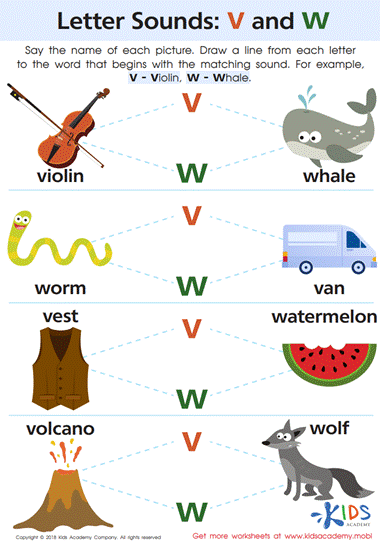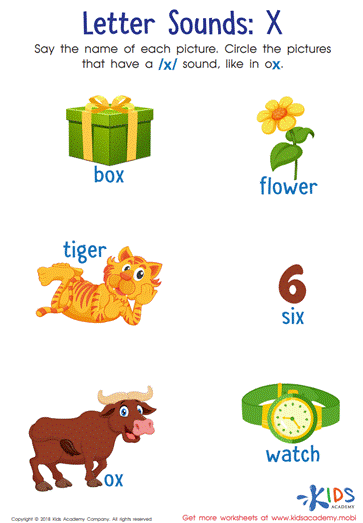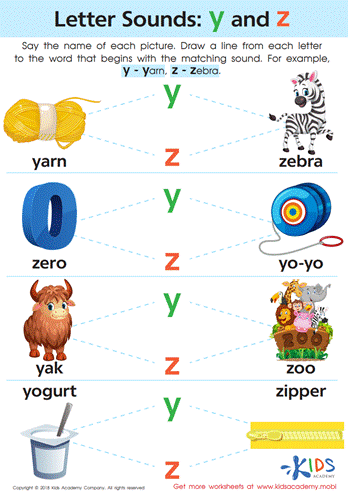-
English
-
English Pre-K
-
Unit 1: Early Literacy Skills
-
ABCs
- Pre-writing Activities
- Letter A
- Letter B
- Letter C
- Letter D
- Letter E
- Letter F
- Letter G
- Letter H
- Letter I
- Letter J
- Letter K
- Letter L
- Letter M
- Letter N
- Letter O
- Letter P
- Letter Q
- Letter R
- Letter S
- Letter T
- Letter U
- Letter V
- Letter W
- Letter X
- Letter Y
- Letter Z
-
Phonological Awareness
- Rhyming Words
- Letter Sounds B, C, D, and F
- Letter Sounds G, H, J, and K
- Letter Sounds L, M, N, and P
- Letter Sounds Q, R, S, and T
- Letter Sounds V, W, X, Y, and Z
- Letter Sounds A, E, and I
- Letter Sounds O and U
- Beginning Sounds
- Matching Letters to Sounds
-
ABCs
-
Unit 2: Vocabulary
-
Common Words
- Sorting Words into Categories
- Color Words
- Verbs and Adjectives
-
Sight Words
- Sight Words 'I' and 'Can'
- Sight Words 'You' and 'Like'
-
Common Words
-
Unit 3: Print Awareness
-
Parts of a Book
- Working with a Book
- Spaces Between Words
- Text and Illustrations
-
Picture Books and Poems
- Picture Book Text Features
- Poem Text Features
- Signs and Labels in the Community
-
Parts of a Book
-
Unit 4: Reading Literature
- Questions About Stories
- Discussing Stories
-
Unit 5: Reading Informational Texts
- Retelling Details in a Text
- Questions About a Text
- Connections Between Events
- Text Features
- Describing Illustrations
-
Unit 1: Early Literacy Skills
-
English Pre-K
-
Math
-
Math for Pre-Kindergarten
-
Logic and Geometry
-
Matching and Sorting
- Same and Different
- Which One Is a Little Different?
- Objects That Go Together
- Sorting by Color and Size
- Sorting The Same Group in Different Ways
- Patterns
-
Shapes
- Shapes in Our Environment
- Naming Shapes Regardless of Size
- Making Shapes in Preschool
- Comparing Shapes
- Relative Positions
- Sorting Shapes
-
Matching and Sorting
-
Early Number Sense
-
Numbers 1–5
- Counting to 3
- Counting to 5
- Arranging Objects up to 3 Objects
- Arranging up to 5 Objects
- Writing Numbers 1–5
-
Numbers 1–5
-
Numbers up to 10
- Counting to 10
- Arranging up to 10 Objects
- Number 0
- Writing Numbers 6–10
- Breaking Down Numbers 6-10
-
Logic and Geometry
-
Math for Pre-Kindergarten
Teaching Letter Sounds V, W, X, Y, and Z to a Preschooler
Children acquire a skill at the Pre-K stage called “phonological awareness”. This skill paves the way towards reading and writing. For a child to know how to read, they need to identify each letter-sound in a word and know how to segment these sounds in order to pronounce the word as a whole. For writing, the child needs to know how to spell first, and to spell, they need to know how to identify each letter-sound and blend them together to form a word. Thus, as the child’s caregiver and educator, it is essential to teach them these language skills. Teaching these skills can happen through fun and games instead of pressure and dictation. In this article, you will find a few activities to engage your child in learning the consonant sounds V, W, X, Y and Z.
Letter Sound V
The letter V makes a vibrating /v/ sound. To help your child practice this letter, incorporate some play elements into the learning process. For example, prepare a list of around 10 words, four of which have one letter V (view, volume, violin, visit), and two have it twice (vivid, valve), and the remaining four have no letter V. With a piece of velcro, have your child listen to each of the words in the list, and then open and close the velcro to the number of the letter V in each word. The use of the velcro establishes an association between the letter V and its sound in the word “velcro”.
Letter Sound W
The letter-sound W is used to ask the most important questions: what, why, when and where. All these questions start with the sound /w/ produced by the letter W. To help your child practice this letter, fill a sensory bin with sand or small rocks, then add a few images of things that start with the letter W such as whale, window, water, wood, watch, worm, waffle, wolf, wizard, etc. On a piece of paper, write a list of the objects in the images, and help your child read and search for each item from the list. This mini scavenger hunt activity is fun and helps your child get acquainted with the letter-sound W as you read the words to them, and you have them identify the images themselves.
As the letters V and W look a little similar, help your child differentiate between them through working on this Letter Sounds: V and W phonics worksheet. Have your child say the words aloud, like “worm”, “violin”, and “van”. While working, ask your child to listen intently to how each word is pronounced. Does it start with a W or a V? Then have them trace the dotted line from each letter to its corresponding picture. This worksheet will help your child practice mastering these sounds along the way!
Letter Sound X
The letter X can be a little tricky as its sound at the beginning of a word does not match its name. For a more efficient learning experience, teach your child the letter-sound X at the end of a word instead of the beginning such as in the words box, mix, fox, etc. One way to teach your child the letter X is by playing a word game where you say a word, such as “fall”, and your child has to listen intently and replace the last sound with the letter X, in this case making the word “fox”. The benefit of this activity is that it activates both listening and speaking skills.
Another activity for your little one to learn the letter-sound X is by completing this colorfully illustrated Kids Academy Letter Sounds: X worksheet. Watch as your child names pictures like “box” or “watch”. Then, have them circle the images that end with the letter-sound x. You can help them double check their work by looking for the letter in the word below each image.
Letter Sound Y
The letter Y can produce several sounds. In an initial position, it sounds as /y/, whereas at the end of one syllable words, it sounds as a long /i/ sound, and at the end of two syllable words, it sounds as a long /e/. To help your child get acquainted with the letter, you can start off with teaching them the letter-sound in its initial position. Set up this letter-sound Y activity for your child to make the learning process fun and easy. Print several images of random objects, 5 of which start with the letter Y. On a piece of paper, write a big letter Y on top, and have your child name and identify each image, then glue the ones that start with the sound Y on the paper. If you have a magnetic board available, you can use it instead of the paper, just use magnets to fix the images under the letter Y.
Letter Sound Z
Congratulations, you have reached the last consonant of the alphabet, the letter-sound Z! To help your child learn this sound, try out an activity we like to call “Catching Z’s”. Print out 10 small images of random but familiar objects, making sure 5 of them start with the letter Z (zebra, zipper, zucchini, zero, zombie) and tape them on small colorful balls. Then, prepare 2 baskets, one labeled with “Z”, another labeled with “other”. Have your child name each image and identify which basket it goes into. To add some motor skill practice to it, you can either have them throw the balls into the baskets from a small distance, or you can throw the ball to them and they try to catch it.
To review the last two letter-sounds, offer your child the below Kids Academy “Letter Sounds: Y and Z” worksheet.
To review this lesson, print out 10 images, 2 starting with each of the letters in this lesson: violin, van, worm, wolf, six, box, yo-yo, yarn, zebra, zipper. Cut out a circular shape out of construction paper, and divide it into 5 parts. Label each section with one of the five letters and then have your child sort the 10 images onto the disc using either clothespins or magnets on a fridge/magnetic board. Use our interactive catalogue to find more specific articles on different aspects of phonological awareness.




